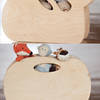Lightning Q&A: How to stay safe when lightning is around

I've compiled a bunch of questions I've been asked about lightning over the years. Some of these are a little repetitive and some are sort of basic, but here's a bunch of information about lightning! Enjoy. (P.S. All of these pictures are my pictures and I hold all the rights to them. Thank you)
Does lightning ever strike the same place twice?
YES! There’s actually a tree in my town that’s been struck multiple times. Very tall structures are struck over and over again!
Is lightning powerful?
YES! One bolt of lightning has about 1,000,000,000 (a BILLION) joules of energy! This will power a 60 watt light bulb for over six months!
Is lightning hot?
YES! Lightning is electricity. Electricity causes heat. A bolt of lightning can heat the air around it by 50,000 degrees F, which is FIVE TIMES hotter than the sun (the surface, anyway). This intense heat is what can ignite fires.
Does lightning strike cloud to ground?
YES, BUT, usually, electrons go from cloud to ground as a stream of protons go from ground to cloud. Lightning happens because the potential difference between the ground and cloud (or from cloud to cloud or within the cloud) becomes too great and lightning basically becomes a giant capacitor.
Does lightning travel a long way?
YES! It can strike 10 miles from the storm, and some bolts can go even farther than that. A lot of people think that the storm is too far away to strike them! During a thunderstorm, each flash of cloud-to-ground lightning can damage or kill. When thunder roars, go indoors!
Does taking shelter in a car protect from lightning?
YES! However, it is not because of the rubber tires. The outer metal shell of a hard-topped metal vehicle is what provides the protection. If you are in a car when it is struck by lightning, you will most likely be perfectly safe; however, the electronics and/or tires and possibly the windows might be damaged. Just don’t touch any part of the metal frame of the car and you should be fine. Convertibles and other soft-topped vehicles do NOT offer any protection from lightning.
Does lightning always strike the tallest object?
NO! Lightning will strike whatever happens to be in its path. EXTREMELY tall objects such as towers and skyscrapers are more likely to be struck only because they SIGNIFICANTLY reduce the space between the cloud and the ground. Objects less than 100 feet high above ground are inconsequential to a lightning strike's final target.
Do planes get struck by lightning?
YES! Commercial planes are designed to withstand a lightning strike, and lightning frequently strikes aircraft. When struck, the lightning enters the metal exterior of the plane, flows across this metal surface, then exits the metal shell elsewhere on the exterior, bypassing everything inside of the plane.
Does metal attract lightning?
NO! Lightning is not ATTRACTED to metal; but, metal wires and poles are great conductors, so electricity from the lightning will travel through them. This is why it is so important to stay away from corded electronics and wires during a thunderstorm.
So, do umbrellas, golf clubs, etc. attract lightning?
NO!, unless the lightning is only a few feet away. Lightning is on a macro scale, not a micro scale. Since lightning is originated in clouds that are miles wide, it doesn’t matter if there is a tiny little metal object on or near the ground.
Is it dangerous to shower during a thunderstorm?
YES! Water may be delivered to your home via metal pipes. As mentioned above, metal is a conductor and “carries” electricity. If lightning strikes the pipe while you are in the shower or even just washing your hands, you could be electrocuted. Water is also a conductor.
Does lightning jump into the air?
YES! Lightning can jump through the air inside a building to reach a better grounding path, such as from electrical wires to a water pipe.
Does lightning kill the animals inside lakes/rivers/water struck by lightning?
NO! Fortunately, most of the electricity from the lightning spreads out along the water’s surface. As long as the fish are not near the surface of the water, they won’t be harmed by the lightning strike.
Should you lie flat on the ground if you’re stranded outside in a thunderstorm?
NO! If you are caught outside in a lightning storm with no way to get to shelter, stay clear of trees or open structures. Crouch down, put your feet together and cover your ears to limit possible hearing damage. Keep at least 15 feet away from other people. You want to make yourself as small as possible, although you are still likely to get hit by the return strike.
Have you been struck by lightning?
























Comments
Kasey
TheStyleWright,com